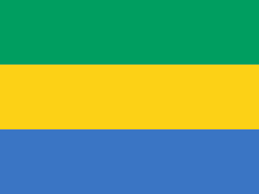Meaning of the Colors of the Gabon Flag
What is the Meaning of the Colors of the Gabon Flag?

The national flag of Gabon stands as a vibrant emblem, rich in symbolism and history. Comprised of three horizontal stripes of green, yellow, and blue, with a centered yellow emblem, this flag encapsulates the essence of Gabonese identity. Each color holds deep significance, reflecting the nation's values, heritage, and aspirations. In this article, we delve into the intricate meanings behind the colors of the Gabon flag, uncovering the stories and symbolism they represent.
Meaning of Colors of Gabon flag
Green: The Lushness of Gabon's Landscapes
The green stripe on the Gabon flag not only represents the country's lush landscapes but also underscores its commitment to environmental stewardship and sustainability. Gabon is renowned for its rich biodiversity, with vast expanses of tropical rainforests that are home to a diverse array of flora and fauna. As such, the color green serves as a reminder of the importance of preserving Gabon's natural heritage for future generations.
In recent years, Gabon has made significant strides in conservation efforts, establishing national parks, wildlife reserves, and protected areas to safeguard its unique ecosystems. The green stripe on the flag symbolizes these efforts, signaling Gabon's dedication to sustainable development, eco-tourism, and biodiversity conservation. It also reflects the country's recognition of the interconnectedness between environmental health, economic prosperity, and social well-being.
Yellow: The Wealth of Gabon's Resources
The prominent yellow stripe on the Gabon flag signifies the country's wealth of natural resources, including oil, minerals, timber, and fisheries. Historically, Gabon's economy has been heavily reliant on the extraction and export of these resources, with oil being the primary driver of economic growth and government revenue. However, in recent years, Gabon has sought to diversify its economy and reduce its dependence on oil, aiming to foster sustainable and inclusive development.
The color yellow thus represents Gabon's aspirations for economic diversification, innovation, and entrepreneurship. It symbolizes the country's potential to harness its natural resources responsibly while investing in sectors such as agriculture, manufacturing, technology, and tourism. By embracing economic diversification, Gabon seeks to create new opportunities for employment, wealth creation, and social advancement, ensuring a more resilient and inclusive economy for all its citizens.
Blue: The Promise of Gabon's Future
The blue stripe at the bottom of the Gabon flag represents the country's maritime heritage, coastal geography, and strategic position along the Atlantic Ocean. Gabon's coastline stretches over 800 kilometers, providing access to valuable marine resources and opportunities for trade, shipping, and maritime connectivity. The color blue symbolizes Gabon's engagement with the wider world, emphasizing its role as a maritime nation and a gateway to the African continent. Moreover, blue conveys Gabon's commitment to international cooperation, diplomacy, and peacekeeping efforts. As a member of regional organizations such as the Economic Community of Central African States (ECCAS) and the African Union (AU), Gabon plays an active role in promoting regional integration, stability, and development. The blue stripe on the flag serves as a reminder of Gabon's commitment to multilateralism, dialogue, and collaboration in addressing global challenges such as climate change, maritime security, and sustainable development.
Historical Context and Evolution
The Gabonese flag, adopted on August 9, 1960, upon gaining independence from France, has undergone several modifications throughout its history. Initially, the flag consisted of three horizontal stripes of green, yellow, and blue, with the yellow stripe being significantly narrower than the others. In 1963, the design was modified to include a wider yellow stripe, symbolizing the nation's growing emphasis on economic development and resource exploitation.
In 1970, following a constitutional amendment, the flag underwent another revision, with the proportions of the stripes being equalized, and the yellow emblem was introduced at the center. This emblem underwent further modifications in 1990, with the addition of the crossed palm branches and the golden sun, enhancing the flag's symbolism and visual appeal.
Cultural and Social Significance
Beyond its official representation, the Gabonese flag holds profound cultural and social significance for the nation's citizens. It serves as a unifying symbol, rallying the Gabonese people around shared values, aspirations, and identity. Whether raised high during national celebrations, draped over buildings, or displayed proudly in homes, the flag fosters a sense of pride, patriotism, and belonging among Gabonese individuals, both at home and abroad.
Moreover, the colors and symbols of the flag are often invoked in various cultural expressions, from traditional artwork and performances to contemporary literature and music. They serve as potent motifs, reflecting Gabon's heritage, resilience, and aspirations for the future. Through its vibrant colors and evocative symbolism, the Gabonese flag continues to inspire and unite generations of Gabonese citizens, embodying the spirit of a nation striving for progress, prosperity, and peace.
Conclusion
In conclusion, the Gabon flag stands as a powerful emblem, rich in symbolism and history, that encapsulates the essence of Gabonese identity. From the lush greenery of its landscapes to the wealth of its natural resources and the promise of its future, each color and symbol on the flag tells a story of resilience, unity, and aspiration. As Gabon continues its journey of nation-building and development, its flag serves as a beacon of hope, guiding its citizens toward a brighter and more prosperous future.
